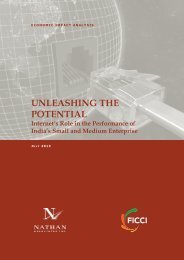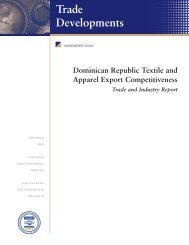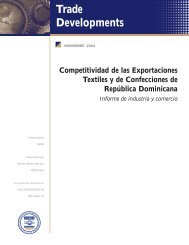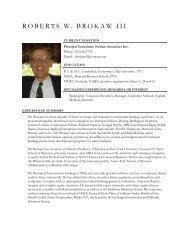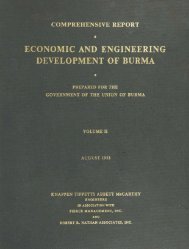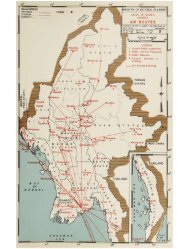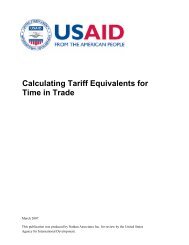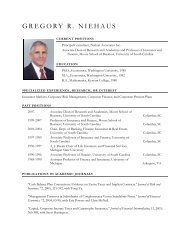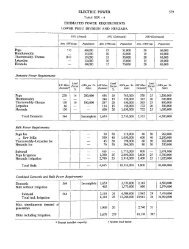Putting it to Work in Developing Countries - Nathan Associates
Putting it to Work in Developing Countries - Nathan Associates
Putting it to Work in Developing Countries - Nathan Associates
Create successful ePaper yourself
Turn your PDF publications into a flip-book with our unique Google optimized e-Paper software.
Further, home country tax policies can have an impact<br />
on the re<strong>in</strong>vested earn<strong>in</strong>gs component of FDI, as U.S.<br />
experience under the Homeland Investment Act of<br />
2004 demonstrates. See Chapter 3, Sources of FDI for<br />
Develop<strong>in</strong>g <strong>Countries</strong> and footnote 6.<br />
CHAPTER 2<br />
1 This typology of FDI flows from the perspective of<br />
the enterprise is based on 1997 deliberations of the<br />
WTO’s <strong>Work</strong><strong>in</strong>g Group on Trade and Investment. See<br />
WTO, Document WT/WGTI/W/8/Add.1,<br />
“Implications of the Relationship between Trade and<br />
Investment for Development and Economic Growth.”<br />
2 See WIR 2002, pp. 154–157.<br />
3 Unilateral and reciprocal preferential trade arrangements<br />
enlarge the effective size of develop<strong>in</strong>g country<br />
markets. The Un<strong>it</strong>ed States grants unilateral or one-way<br />
trade preferences <strong>in</strong> such programs as the Generalized<br />
System of Preferences, the African Growth and<br />
Opportun<strong>it</strong>y Act (AGOA), and the Caribbean Bas<strong>in</strong><br />
Trade Preference Act (CBTPA). The European Union<br />
grants preferences through <strong>it</strong>s Everyth<strong>in</strong>g But Arms<br />
(EBA) program. Japan, Canada, and other developed<br />
countries offer similar arrangements. Under unilateral<br />
preference programs, products orig<strong>in</strong>at<strong>in</strong>g <strong>in</strong> develop<strong>in</strong>g<br />
countries are granted special quota or tariff access.<br />
Such programs often restrict certa<strong>in</strong> products of <strong>in</strong>terest<br />
<strong>to</strong> develop<strong>in</strong>g country exporters, must be renewed<br />
periodically, and can be revoked at any time by the<br />
grant<strong>in</strong>g country. Two or more trade partners may<br />
negotiate an arrangement <strong>in</strong> which they grant reciprocal<br />
preferences that are not necessarily permanent. By<br />
contrast, trade agreements between countries are b<strong>in</strong>d<strong>in</strong>g,<br />
cannot be revoked unilaterally w<strong>it</strong>hout penalty,<br />
and do not require periodic renewal.<br />
4 Specialists <strong>in</strong> the World Bank’s Foreign Investment<br />
Advisory Services note that “FDI is <strong>in</strong>creas<strong>in</strong>gly market<br />
seek<strong>in</strong>g … offer<strong>in</strong>g opportun<strong>it</strong>ies <strong>to</strong> any country will<strong>in</strong>g<br />
<strong>to</strong> open <strong>it</strong>s markets or <strong>in</strong>tegrate w<strong>it</strong>h <strong>it</strong>s neighbors.”<br />
See V<strong>in</strong>cent Palmade and Andrea Anayiotas, “FDI<br />
Trends,” Public Policy for the Private Sec<strong>to</strong>r, September<br />
2004, p. 3. Indeed, s<strong>in</strong>ce the 1980s, market-seek<strong>in</strong>g<br />
FDI stimulated by regional trade arrangements appears<br />
<strong>to</strong> have <strong>in</strong>creased substantially, particularly where lesser<br />
developed and more developed countries are part of the<br />
same regional trade group.<br />
5 This is known as the “ladder effect.” For example, <strong>in</strong><br />
the late 1980s and early 1990s, labor-<strong>in</strong>tensive manufactur<strong>in</strong>g<br />
<strong>in</strong> electronics or <strong>in</strong>dustrial equipment migrated<br />
rapidly from the Un<strong>it</strong>ed States and Europe <strong>to</strong><br />
Ch<strong>in</strong>a. As costs began <strong>to</strong> rise <strong>in</strong> Ch<strong>in</strong>a <strong>in</strong> the mid<br />
1990s, these operations shifted <strong>to</strong> other lower wage<br />
locations <strong>in</strong> Asia. At the same time, a wave of more<br />
complex, value-added components manufactur<strong>in</strong>g cont<strong>in</strong>ued<br />
<strong>to</strong> move out of U.S. and European fac<strong>to</strong>ries <strong>to</strong><br />
these now more experienced but far less costly Ch<strong>in</strong>ese<br />
manufactur<strong>in</strong>g facil<strong>it</strong>ies, replac<strong>in</strong>g the manufactur<strong>in</strong>g<br />
sent on <strong>to</strong> South or Southeast Asia.<br />
6 Of course, global production networks and value<br />
cha<strong>in</strong>s <strong>in</strong> manufactur<strong>in</strong>g and <strong>in</strong> services can be set up<br />
by equ<strong>it</strong>y (FDI) and nonequ<strong>it</strong>y means (outsourc<strong>in</strong>g<br />
through subcontract<strong>in</strong>g). Where FDI leads <strong>to</strong> the creation<br />
of foreign affiliates for a parent mult<strong>in</strong>ational<br />
enterprise, vertical <strong>in</strong>tegration of production is ma<strong>in</strong>ta<strong>in</strong>ed.<br />
In general, where absolute lowest-cost labor<br />
motivates a mult<strong>in</strong>ational’s efficiency-seek<strong>in</strong>g (e.g., <strong>in</strong><br />
textiles or footwear), subcontract<strong>in</strong>g may be the mechanism<br />
of choice; where some technology and skilled<br />
labor <strong>in</strong>puts figure more <strong>in</strong> the production process, an<br />
FDI-based approach may be preferred.<br />
7 Lenovo Group chairman Liu Chuanzhi quoted <strong>in</strong> the<br />
New York Times, December 25, 2004.<br />
8 For example, FDI <strong>in</strong> such extractive <strong>in</strong>dustries as<br />
m<strong>in</strong><strong>in</strong>g, quarry<strong>in</strong>g and petroleum is largely resourceseek<strong>in</strong>g,<br />
while FDI <strong>in</strong> au<strong>to</strong>motive manufactur<strong>in</strong>g is<br />
likely efficiency-seek<strong>in</strong>g, and <strong>in</strong> service <strong>in</strong>dustries such<br />
as f<strong>in</strong>ance or electric<strong>it</strong>y, gas, and water, <strong>it</strong> is probably<br />
market-seek<strong>in</strong>g.<br />
9 Ample empirical research shows how FDI’s favorable<br />
impact on domestic <strong>in</strong>vestment affects cap<strong>it</strong>al accumulation.<br />
Other external resource <strong>in</strong>flows (i.e., portfolio<br />
equ<strong>it</strong>y or debt) <strong>to</strong> develop<strong>in</strong>g countries often fuel higher<br />
consumption or growth of foreign exchange reserves,<br />
but an <strong>in</strong>crease <strong>in</strong> FDI appears <strong>to</strong> end up as a one-<strong>to</strong>one<br />
<strong>in</strong>crease <strong>in</strong> real sec<strong>to</strong>r <strong>in</strong>vestment. See Bosworth<br />
and Coll<strong>in</strong>s, “Cap<strong>it</strong>al Flows <strong>to</strong> Develop<strong>in</strong>g Economies:<br />
Implications for Sav<strong>in</strong>gs and Investment.” And, contrary<br />
<strong>to</strong> fears that FDI-f<strong>in</strong>anced foreign affiliates borrow<br />
heavily from host-country banks and “crowd out”<br />
local firms, exacerbat<strong>in</strong>g f<strong>in</strong>anc<strong>in</strong>g constra<strong>in</strong>ts, there is<br />
evidence that FDI eases constra<strong>in</strong>ts. This holds true for<br />
high- and low-<strong>in</strong>come countries, and for purely domestic<br />
firms. See Ann E. Harrison, Inessa Love, and<br />
Margaret S. McMillan, “Global Cap<strong>it</strong>al Flows and<br />
F<strong>in</strong>anc<strong>in</strong>g Constra<strong>in</strong>ts,” Journal of Development<br />
Economics, 75 (2004). Most dramatically, by stimulat<strong>in</strong>g<br />
complementary economic activ<strong>it</strong>ies, FDI may<br />
“crowd <strong>in</strong>” domestic <strong>in</strong>vestment by an estimated fac<strong>to</strong>r<br />
of 1.5 <strong>to</strong> 2.3. See E. Borenszte<strong>in</strong>, J. De Gregorio, and<br />
J-W Lee, “How Does Foreign Direct Investment Affect<br />
Economic Growth” Journal of International Economics<br />
45 (1998). Another recent study concludes that FDI is<br />
less likely <strong>to</strong> crowd out and more likely <strong>to</strong> crowd <strong>in</strong><br />
domestic <strong>in</strong>vestment <strong>in</strong> develop<strong>in</strong>g countries than <strong>in</strong><br />
developed ones. It f<strong>in</strong>ds that research lead<strong>in</strong>g <strong>to</strong> a contrary<br />
result may derive from <strong>in</strong>appropriate pool<strong>in</strong>g of<br />
data across develop<strong>in</strong>g and developed economies. See<br />
Bruce A. Blonigen and Miao Grace Wong,<br />
“Inappropriate Pool<strong>in</strong>g of Wealthy and Poor <strong>Countries</strong><br />
92



